Eni Bundle
How Did Eni Become a Global Energy Powerhouse?
Journey back in time to uncover the Eni SWOT Analysis and the fascinating Eni history. From its Eni origins as an Italian energy company, Eni's evolution reflects strategic foresight and bold innovation. Discover the key milestones that shaped this Eni company into a global leader.
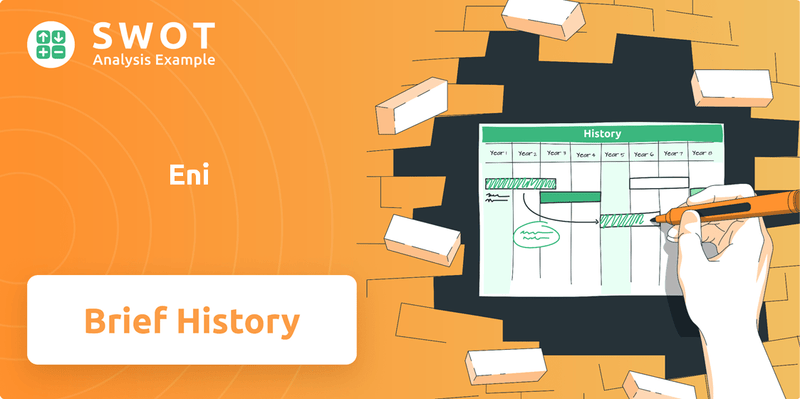
This Eni brief history explores the pivotal moments that defined its trajectory, including its early focus on natural gas and the influence of figures like Enrico Mattei. Explore Eni's expansion into international markets and the Eni timeline. Understanding the past is crucial for grasping Eni's current market position and its future in the ever-changing energy landscape.
What is the Eni Founding Story?
The Eni company has a rich history, officially beginning on February 10, 1953. This marked the formal establishment of Eni S.p.A. through the consolidation of several state-owned entities. The most prominent of these was AGIP (Azienda Generale Italiana Petroli), which had been in operation since April 3, 1926.
Enrico Mattei is recognized as the key figure behind Eni's creation and early strategic direction, even though he wasn't a traditional founder. Appointed commissioner of AGIP in 1945, Mattei transformed the company. He championed a strong, state-controlled energy sector.
The initial challenge was Italy's dependence on foreign energy sources. The goal was to develop domestic hydrocarbon reserves to support post-war economic recovery. Eni's early business model focused on exploring, producing, and distributing oil and natural gas within Italy. A key early success was the discovery of natural gas in the Po Valley. Mattei's approach to international oil concessions, offering better terms than the established companies, was a hallmark of Eni's early strategy. This approach helped secure resources and build partnerships, contributing to its initial funding and growth.
Eni's early exploration efforts were marked by determination, especially in finding natural gas in Italy.
- Mattei's persistence led to crucial discoveries that shaped Eni's future.
- The post-World War II context, with a strong desire for national reconstruction, influenced Eni's mission.
- Eni aimed to secure the nation's energy future.
- Eni's history is a testament to strategic vision and resilience.
Eni SWOT Analysis
- Complete SWOT Breakdown
- Fully Customizable
- Editable in Excel & Word
- Professional Formatting
- Investor-Ready Format
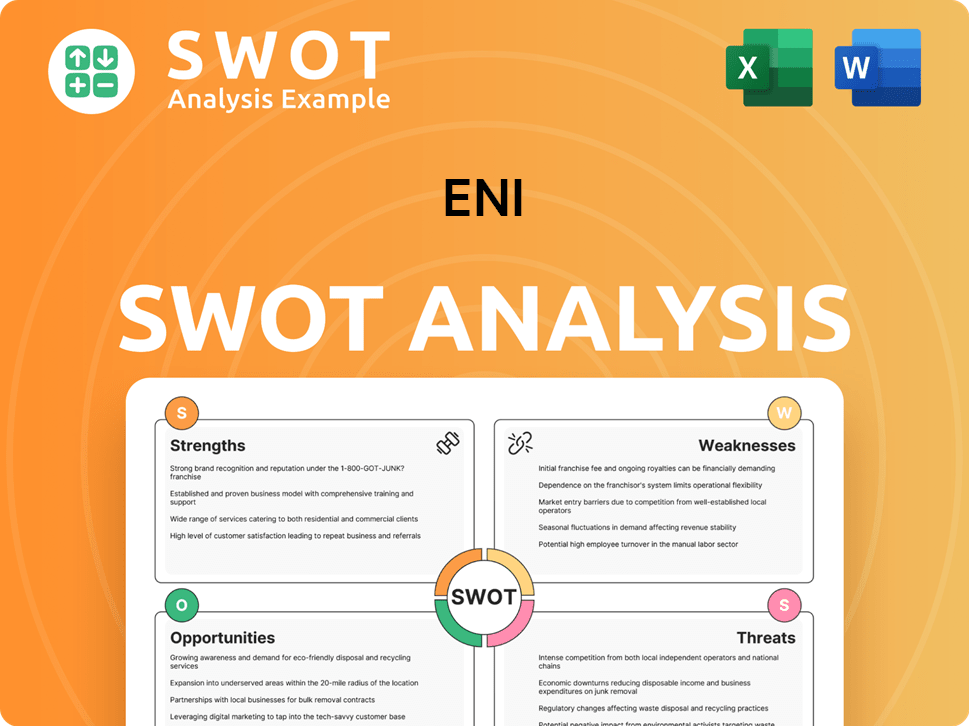
What Drove the Early Growth of Eni?
The early growth and expansion of the Eni company, an Italian energy company, were characterized by aggressive exploration and strategic diversification. Following its establishment, Eni rapidly intensified its natural gas exploration efforts in the Po Valley. By the late 1950s and early 1960s, Eni expanded internationally, particularly in Africa and the Middle East, using innovative partnership agreements.
Eni's early exploration efforts focused heavily on the Po Valley, leading to significant natural gas discoveries. This was crucial for Italy's energy supply. The company then expanded into international markets. This expansion included ventures in Africa and the Middle East.
Eni pioneered innovative partnership agreements that challenged traditional concession models. These agreements often included provisions for local participation and profit-sharing. This approach allowed Eni to gain access to promising territories. These strategies were pivotal in the company's early international success.
A key early product launch was the widespread distribution of natural gas for industrial and residential use. This was facilitated by the construction of an extensive pipeline network. Eni also expanded its refining and marketing operations. These moves established a strong presence in the downstream sector.
Major capital raises were primarily through state funding, reflecting Eni's role as a national energy champion. Leadership transitions, particularly after Enrico Mattei's death in 1962, were significant. The company continued its international expansion while navigating complex geopolitical landscapes. For more information on the competitive landscape, you can read about the Competitors Landscape of Eni.
By the 1970s, Eni had established a significant international footprint, with operations across multiple continents. The market reception to Eni's aggressive expansion was generally positive. This contributed to global energy supply diversification. The company's unique partnership approach allowed it to carve out its niche.
Pivotal decisions included the strategic emphasis on natural gas and integrated operations. Eni focused on the entire energy value chain, from exploration to distribution. In 2023, Eni's gas sales volumes reached 73.57 billion cubic meters, demonstrating its sustained focus on this segment. The company's early decisions shaped its trajectory.
Eni PESTLE Analysis
- Covers All 6 PESTLE Categories
- No Research Needed – Save Hours of Work
- Built by Experts, Trusted by Consultants
- Instant Download, Ready to Use
- 100% Editable, Fully Customizable
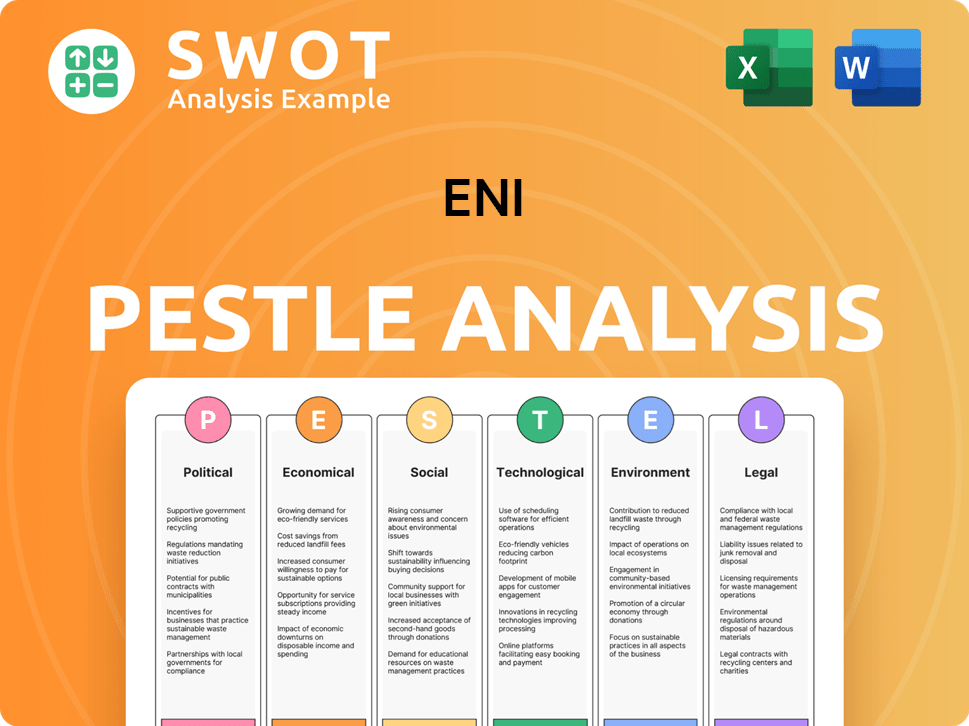
What are the key Milestones in Eni history?
The Eni company has a rich history marked by significant milestones that have shaped its trajectory as a leading Italian energy company. From its origins to its current position, Eni's journey reflects strategic adaptations and a commitment to innovation in the energy sector.
| Year | Milestone |
|---|---|
| 1953 | Eni was founded, marking its origins in the Italian energy sector. |
| 1950s-1960s | Eni pioneered unique partnership models, offering more equitable terms to producing countries. |
| 1970s | The oil crises significantly impacted Eni's operations, necessitating strategic adjustments. |
| 2000s-Present | Eni expanded into renewable energy and decarbonization initiatives, aiming for net-zero emissions by 2050. |
Eni has consistently been at the forefront of innovation, particularly in exploration technologies. The company's early adoption of advanced exploration methods led to significant oil and gas discoveries globally, enhancing its operational capabilities. Furthermore, Eni's strategic pivot towards sustainability, including investments in renewable energy, showcases its commitment to adapting to the evolving energy landscape.
Eni was among the first to use advanced exploration technologies, contributing to significant oil and gas discoveries worldwide. This early focus on innovation helped the company secure resources and expand its global footprint.
Eni pioneered unique partnership models in the 1950s and 1960s, offering producing countries more equitable terms. This approach allowed Eni to access resources in regions often closed to other international oil companies.
Eni has a clear strategy to achieve net-zero emissions by 2050, demonstrating a significant strategic pivot towards sustainability. This involves substantial investments in renewable energy projects and biofuels.
Eni has invested heavily in renewable energy projects, including solar and wind farms, as part of its broader sustainability goals. These initiatives are key to reducing its carbon footprint.
Eni is actively involved in the development of biofuels to reduce its reliance on traditional fossil fuels. This includes research and production of sustainable alternative fuels.
Eni continuously invests in technological advancements across its operations, from exploration to refining. This includes digital transformation initiatives to improve efficiency and sustainability.
Despite its successes, Eni has faced several challenges throughout its history. Market downturns and geopolitical instability in key operating regions have posed significant hurdles. The oil crises of the 1970s and the inherent volatility of commodity prices have also impacted the company.
Eni has had to navigate through periods of economic recession and market volatility, which have impacted its profitability. These downturns require strategic adjustments and cost-saving measures.
Operating in regions with political instability has presented challenges for Eni, including operational disruptions and security concerns. This necessitates careful risk management strategies.
Fluctuations in commodity prices, particularly oil and gas, have a direct impact on Eni's revenue and profitability. The company must adapt to changing market conditions.
Environmental concerns and increasing regulatory scrutiny have pushed Eni to invest heavily in sustainable practices and cleaner energy solutions. This involves significant financial commitments.
Eni faces ongoing regulatory scrutiny, which requires the company to comply with stringent environmental standards and reporting requirements. This impacts operational costs and strategies.
Eni's adjusted exploration & production (E&P) capex for 2024 is projected to be around €6.5 billion, reflecting ongoing investment in its core business while also allocating resources to new energy initiatives. This requires careful financial planning.
Eni Business Model Canvas
- Complete 9-Block Business Model Canvas
- Effortlessly Communicate Your Business Strategy
- Investor-Ready BMC Format
- 100% Editable and Customizable
- Clear and Structured Layout
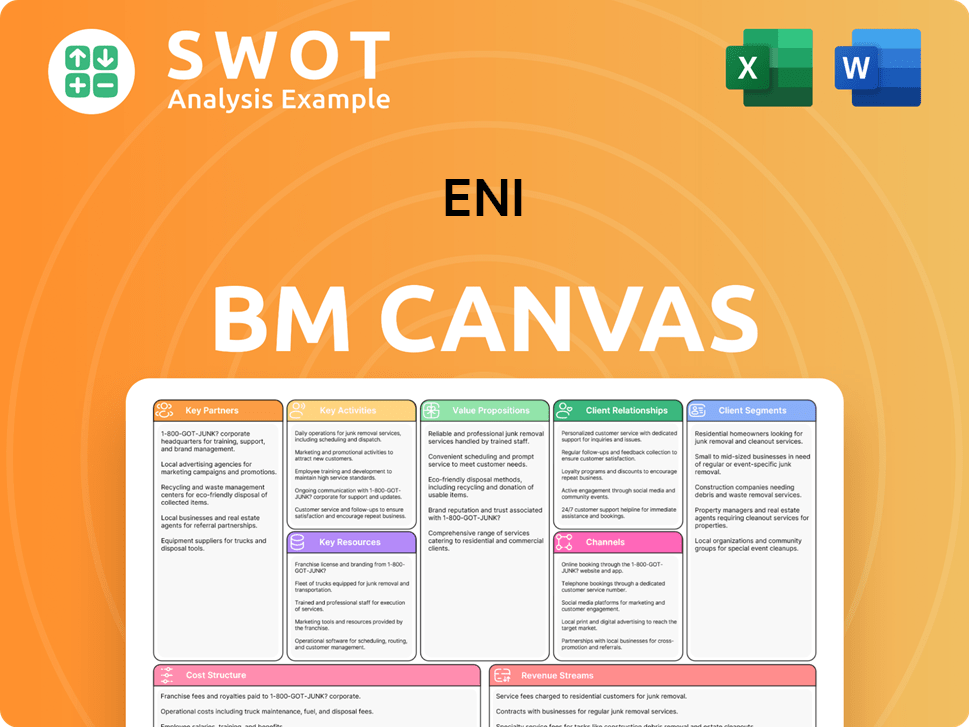
What is the Timeline of Key Events for Eni?
The Eni history is marked by significant achievements and transformations. The
Italian energy company
has evolved from itsEni origins
to become a global leader in the energy sector. Understanding theEni timeline
helps to appreciate its growth and impact. The company has demonstrated resilience and innovation throughout its history, adapting to changing market dynamics and technological advancements.| Year | Key Event |
|---|---|
| 1953 | Eni was founded by Enrico Mattei, marking the beginning of its journey as an integrated energy company. |
| 1950s-1960s | Eni expanded its operations, focusing on exploration and production, and playing a key role in Italy's post-war economic development. |
| 1990s | The company underwent privatization, opening it up to international investors and expanding its global presence. |
| 2000s | Eni diversified its portfolio, increasing its focus on natural gas and renewable energy sources. |
| 2020s | Eni continues to invest in sustainable energy solutions and technologies, aiming to reduce its carbon footprint and support the energy transition. |
Eni is heavily investing in decarbonization strategies. This includes expanding renewable energy capacity, exploring carbon capture and storage projects, and reducing emissions from its existing operations. The company aims to achieve net-zero emissions by 2050. In 2023, Eni's investments in renewable energy reached approximately $1.5 billion.
The company is increasing its renewable energy capacity through wind and solar projects. Eni plans to significantly increase its renewable energy production capacity in the coming years. By 2025, Eni aims to have a renewable energy capacity of over 6 GW, and by 2030, it targets over 15 GW.
Eni continues to form strategic partnerships and make acquisitions to strengthen its position in the energy market. These deals often focus on expanding its presence in key regions, accessing new technologies, and diversifying its portfolio. The company has recently acquired stakes in several offshore wind projects.
Eni is investing in innovative technologies to improve operational efficiency and reduce environmental impact. This includes digital transformation, advanced materials, and exploring new energy sources. The company is actively involved in research and development projects to advance its technological capabilities. Eni is focused on hydrogen production and carbon capture technologies.
Eni Porter's Five Forces Analysis
- Covers All 5 Competitive Forces in Detail
- Structured for Consultants, Students, and Founders
- 100% Editable in Microsoft Word & Excel
- Instant Digital Download – Use Immediately
- Compatible with Mac & PC – Fully Unlocked
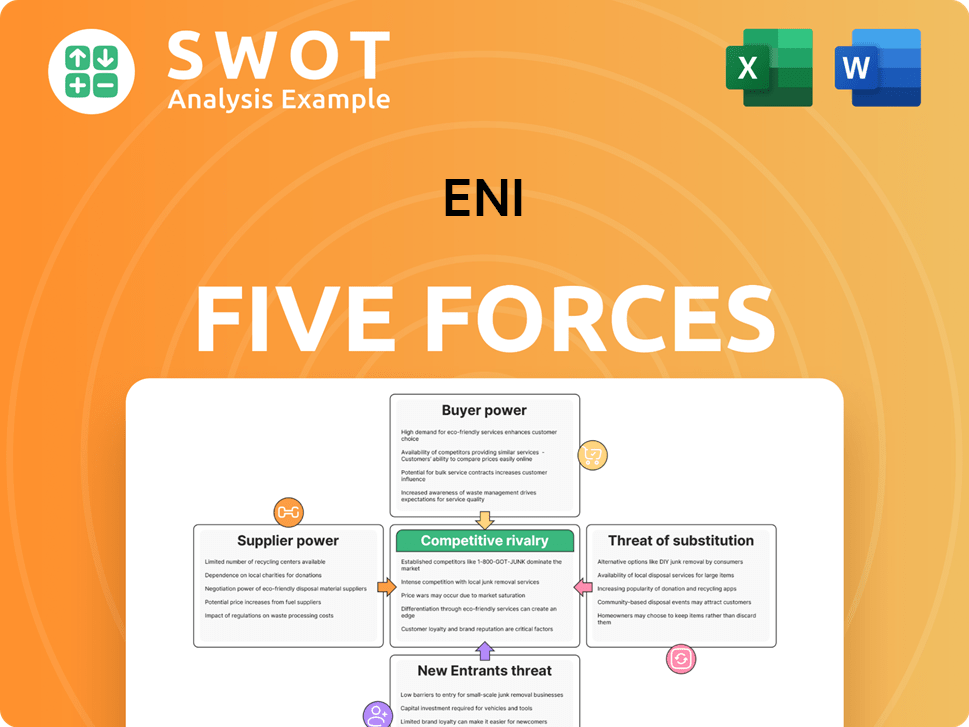
Related Blogs
- What is Competitive Landscape of Eni Company?
- What is Growth Strategy and Future Prospects of Eni Company?
- How Does Eni Company Work?
- What is Sales and Marketing Strategy of Eni Company?
- What is Brief History of Eni Company?
- Who Owns Eni Company?
- What is Customer Demographics and Target Market of Eni Company?
Disclaimer
All information, articles, and product details provided on this website are for general informational and educational purposes only. We do not claim any ownership over, nor do we intend to infringe upon, any trademarks, copyrights, logos, brand names, or other intellectual property mentioned or depicted on this site. Such intellectual property remains the property of its respective owners, and any references here are made solely for identification or informational purposes, without implying any affiliation, endorsement, or partnership.
We make no representations or warranties, express or implied, regarding the accuracy, completeness, or suitability of any content or products presented. Nothing on this website should be construed as legal, tax, investment, financial, medical, or other professional advice. In addition, no part of this site—including articles or product references—constitutes a solicitation, recommendation, endorsement, advertisement, or offer to buy or sell any securities, franchises, or other financial instruments, particularly in jurisdictions where such activity would be unlawful.
All content is of a general nature and may not address the specific circumstances of any individual or entity. It is not a substitute for professional advice or services. Any actions you take based on the information provided here are strictly at your own risk. You accept full responsibility for any decisions or outcomes arising from your use of this website and agree to release us from any liability in connection with your use of, or reliance upon, the content or products found herein.